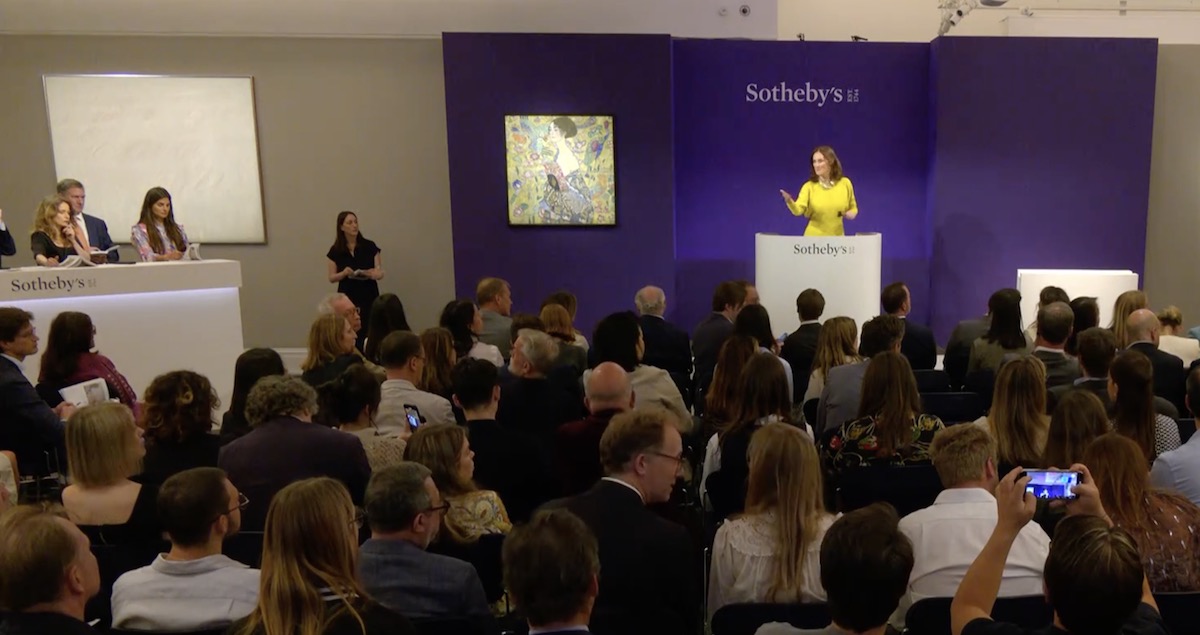Dame mit Fächer (Lady with a Fan) 1917/8, the last portrait Gustav Klimt created before his untimely death, has sold in London for £85.3 million ($108.4 million) at Sotheby’s, setting a new record for the most expensive work of art ever auctioned in Europe.
The painting was still on the easel in Klimt’s studio when he died in 1918. At this stage in his career, Klimt produced fashionable paintings for Viennese society patrons. This is not one of his best. It is an insipidly coloured, sugar coated, loosely painted composition, relying heavily on cultural appropriation from Japan. The composition is not dissimilar to “La Japonaise”, an 1876 oil painting by the French Impressionist Claude Monet, who created his work nearly forty years before Klimt. It is certainly not as fine an example of his work as the record breaking portrait of Adele Bloch-Bauer I, 1907, now in the Neue Gallery in New York. Ronald Lauder bought the painting for a reported US $135 million in 2006.

Gustav Klimt is widely regarded as one of the most significant artists of the late 19th and early 20th centuries. While he is often associated with the Art Nouveau movement and his decorative and ornamental style, Klimt’s contributions to the art world go beyond applied art.
Klimt’s paintings often feature highly stylised and intricate compositions characterised by elaborate patterns, symbolism, and sensuality. His works explore themes such as love, desire, life, and death, and he is mainly known for his portraits and allegorical paintings.
His famous painting, “The Kiss,” exemplifies his unique style and artistic vision. The painting combines fine and applied art elements, showcasing Klimt’s mastery of both realms. His use of gold leaf and decorative motifs adds to his works a luxurious and ornamental quality.
While Klimt’s association with the Vienna Secession and his collaborations on architectural projects and murals demonstrate his involvement in applied art, it is important to recognise that his paintings stand alone as significant artistic achievements. His innovative use of colour, composition, and symbolism, combined with his ability to capture the human form with grace and sensuality, solidify his place as a great painter.
Klimt is considered a society painter to some extent. During his career, he received numerous commissions from wealthy patrons, including members of Vienna’s high society. He painted portraits of aristocrats, industrialists, and other affluent individuals, capturing their likenesses and reflecting their social status.
Klimt’s ability to portray his subjects with a sense of opulence and refinement made his works popular among the upper class. His portraits often depicted individuals in lavish clothing adorned with luxurious accessories, reflecting the wealth and status of his subjects.
Klimt was a prominent figure in Vienna’s cultural scene and was associated with the Vienna Secession, a group of artists who sought to break away from traditional academic art. The Vienna Secession and its members connected with Vienna’s elite and received support from wealthy patrons. Klimt’s involvement with the Vienna Secession and his participation in its exhibitions further solidified his status as a society painter.
It is worth noting that Klimt’s artistic output was not limited to societal portraiture. He also explored various themes and subjects beyond the realm of high society. His allegorical and symbolic paintings, as well as his landscapes and other figurative works, showcase his versatility as an artist.
While Klimt’s association with Vienna’s upper class and his portrayal of wealthy patrons contribute to his classification as a society painter, it is vital to recognise the breadth and depth of his artistic contributions beyond this particular genre.
The recently auctioned Dame mit Fächer (Lady with a Fan) 1917/18 to be clear, is not one of the great examples of Klimt’s work and just another benchmark of hyped Western art packaged and sold back to the region it was appropriated from.

